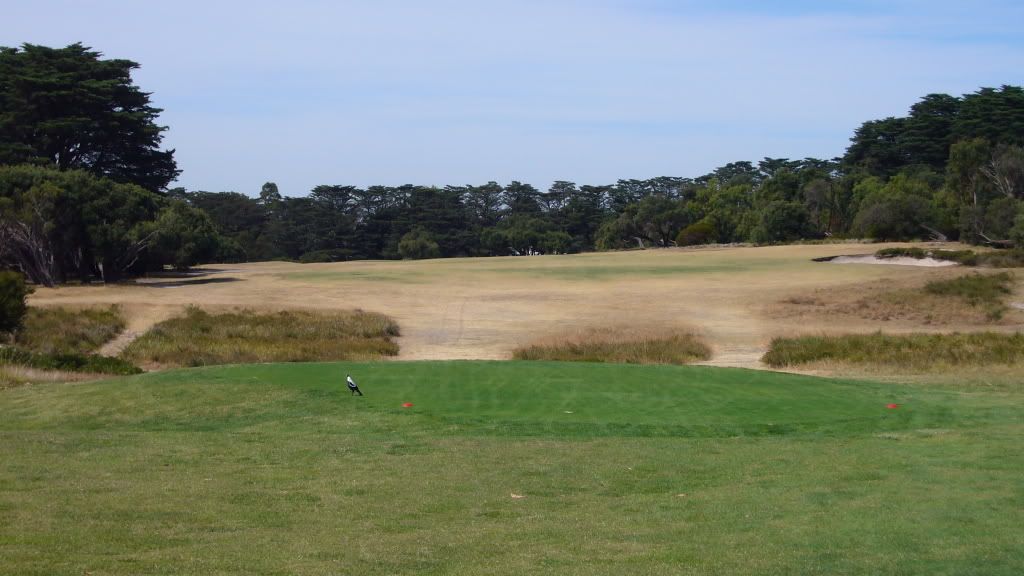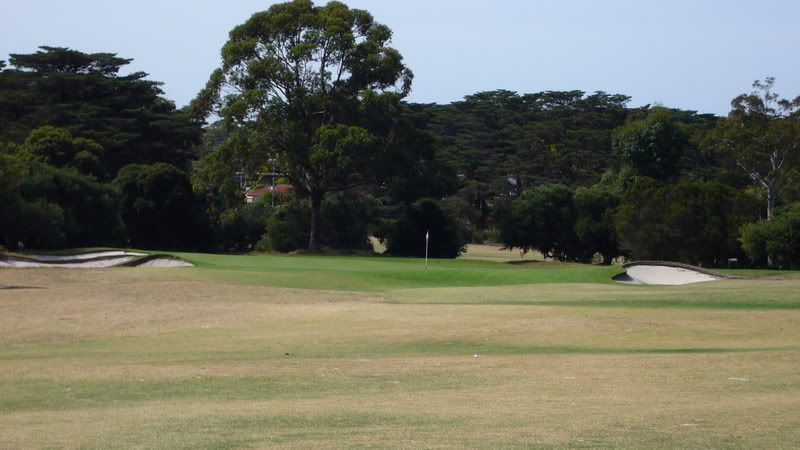If the club gave thematic names to its holes, could it come up with a better name for the 13th (RMW 3) than "foozle"? Because, let's face it, that's what many of us do somewhere along the hole. Especially from 100 yards down to, say, 2 feet. Calling it "Foozle" would be of immeasurable value to our expectations, to say nothing of our self-esteem.
The 13th, a little downhill 355 yarder that some insist should be given a par of 6, might be the most representative hole of the entire 36-hole golfing complex.
The 13th singles out the golfer who fails Peter Thomson’s test of “summing up and loss-cutting,” who stands on the tee and curls his hand into a fist around an expected 3, which in time becomes a hoped-for 4, which in time becomes a grinding 5…
Off the tee, the golfer must decide where to place his ball. He must have a keen self-knowledge of wedge distances and spin control – the key is to be able to land the approach shot within the small area that fits his self-assessed wedge-game strengths.
Note off the tee two recurrent themes, one highlighting the excellent routing the other the excellent terrain: a dogleg left, and a side slope, in this case shortening the hole
After spraying our tee ball -- on this hole, "spraying" counts as being 10-15 yards or so too left, too right, too long or too short -- the rest of us employ the audacity of hope. Because, pretty much, that's all we've got left.
"Please, not in the left-hand bunker, not in the swale...uh, not in the right-hand bunker...please not anywhere short..."
Eventually the golfer discovers the science of loss-cutting involves apparently "irrational" actions like hitting one’s approach shot purposely long. Might as well have a say in the matter; the green is a slick fallaway and one way or another the golfer will be back there after 2, or in 3 if 2 landed in the bunker or chunked its way into the swale just short – or even more horrifyingly,
short of the swale.
Let’s watch one golfer get the full treatment:
The tee shot is a lovely blast to a wee 30 yards, but a shade left of desired – problem as flag is left of center.
Second shot’s only job is to avoid the left-hand bunker. But golfer, thinking 30 yards equals birdie when the reality of his position is hope-for-par, challenges the bunker too much and the pitch trickles in.
Third shot is a beautiful feathered sand shot, which floats out of the bunker, lands perhaps a yard on the green…and trickle-runs all the way off the back.
Lying four and clearly rattled, the golfer must now pitch the ball up (the green is elevated) and get to the hole, yet not so boldly as to challenge the bunker that now appears behind the hole, a bunker for which the golfer now sports a robust respect -- some would say a "foozler's fear" -- although really now can it really be in play anywhere other than the golfer’s mind, it would take one heck of a foozle, but isn't that possible given what we've experienced so far -- enough! Chip it up...And so the fourth shot makes the green, just.
Two putts later, six!
Before each shot, the golfer had the option of protecting against the worst, or taking a chance. Similarly,
after each shot, the golfer had the option of tearing up his prior plan and developing a new one. If wisdom is the accumulation of experience…
Subsequent plays charitably may be described as a progressive exercise in learning how to play defense…on a drive-and-pitch hole…with no water, canyons, or cliffs…
This hole is in a cold-hearted academic way an excellent study in gravity. This photo from Ran's writeup illustrates, as well as showing the ridge and furrow that run seamlessly from fairway to green and define the play of the entire hole:

Honestly, I still don't know the right way to play this hole, but I think a lot of it comes down to the hole location. You've got to peek over at the green from RMW 2 as you can't see the flag from the tee. If the flag is back, a little pitch might be the play, even though you'll likely end up with a downhill putt. If the flag is up, a full wedge might be the play, assuming one can spin the ball enough to keep it in the middle of the green. Jeez, do I have this analysis backwards?
Probably I would be better off pretending no flag was present -- that front-right hole location shown in the two photos is the pictorial representation of score-death. Absolute death, I tell you!
Honestly, all I know is you never, ever want to be in that front-left bunker or in the swale short. Well, all I
think I know -- I'm not so sure of anything with this hole. One hypothesis I'm working on is that, at least when the flag allows, you want to be perpendicular to the swale for your approach, but the line of approach cannot be over or near the right-hand bunker. Of course, the perpendicular may bring in the left-hand bunkers, and did I mention you never ever want to be in them?
Mark